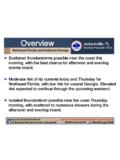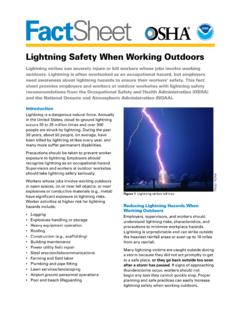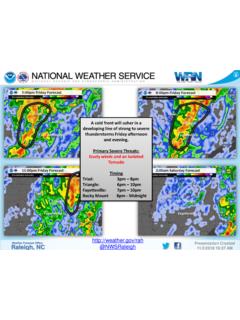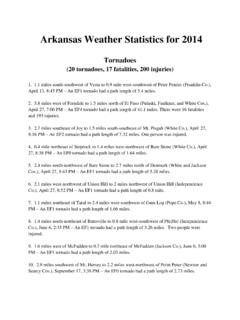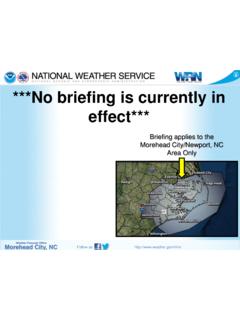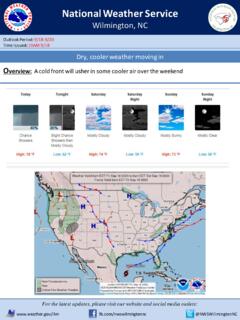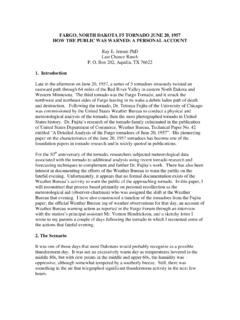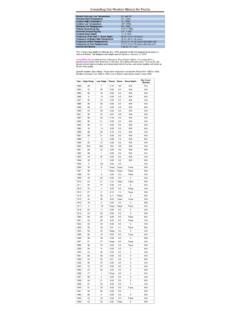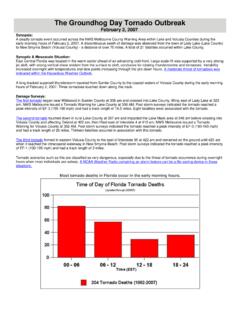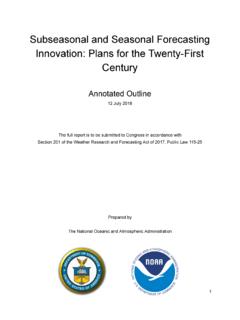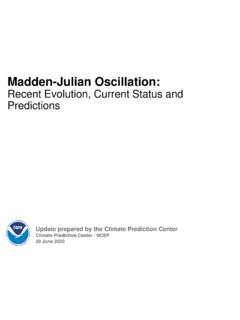Transcription of Chapter 7 Stability and Cloud Development
1 1 Chapter 7 Stability and Cloud DevelopmentAtmospheric Stability2 Cloud Development - stable environment Stable air (parcel)- vertical motion is inhibited if clouds form, they will be shallow, layered clouds like stratus Cloud Development - unstable environment Unstable air (parcel) - vertical motion occurs commonly produces cumulus, cumulonimbus clouds A ball in water: When does it rise? When does it sink? An air parcel: Density Lighter than environment, it will rise. Heavier than environment, it will sink. What determine air density at a given pressure: Temperature How to determine atmospheric Stability ?3 Determining Air Parcel Temperature: Rising air parcels and adiabatic cooling consider a rising parcel of air -->> As the parcel rises, it will adiabatically expand and cool adiabatic- a process where the parcel temperature changes due to an expansion or compression, no heat is added or taken away from the parcelConsider a sinking parcel of air -->>Adiabatic lapse rate As a parcel of air rises, it cools, but at what rate?
2 Lapse rate rate of temperature change with height units of lapse rate are C km-1 Dry-adiabatic lapse rate unsaturated parcels cool at a rate of 10 C km-1- this is called the dry-adiabatic lapse rate Moist Adiabatic Lapse Rate For a saturated parcel of air, , when its T=Td, then it cools at the moist adiabatic lapse rate= 6 C km-1 Q: Why does the parcel cool at a slower rate (6 C km-1) when it is saturated than at 10 C km-1when it is unsaturated?4 Dry versus Moist-Adiabatic Process the moist adiabatic lapse rate is less than the dry adiabatic lapse rate because as vapor condenses into water (or water freezes into ice) for a saturated parcel, latent heat is released into the parcel, mitigating the adiabatic cooling Moist adiabatic lapse rate: vary with temperature and pressure5 Assessing Atmospheric Stability The bottom line - To determine whether or not a parcel will rise or sink in the atmosphere, one must compare the parcels temperature (Tp) with that of the environment (Te) at some altitude: if Tp> Tewhat will the parcel do?
3 If Tp= Tewhat will the parcel do? if Tp< Tewhat will the parcel do? So, to assess Stability , what two pieces of information do we need?Absolute Stability Generally, notice that Teis always larger than Tspand Tupat any level Hence, an unsaturated or saturated parcel will always be coolerthan the environment and will sink back down to the ground The condition for absolute Stability is: d > m > e dis the dry adiabatic lapse rate(10 C km-1) mis the moist adiabatic lapse rate(6 C km-1) eis the environmental lapse rateTup:the temperature of an unsaturated parcelTsp:temperature of a saturated parcelTe:environmental temperature 6 Stability of Inversion Layers Q: How would you characterize the Stability of an inversion layer? They are absolutely stable Note that the absolute Stability criteria: e< m< d Q: How do you form stable layers in the atmosphere? Radiational Cooling -radiation inversion cold air moving in at low levels warm air moving over cold groundCold surface air, on this morning, produces a stable atmosphere that inhibits vertical air motions and allows the fog and haze to linger close to the of subsidence Inversions How does the Stability change for a descending layer of air?
4 The top of the layer warms more than the bottomNatural Stability The environmental lapse rate is equal to the dry adiabatic rate. Or when parcel is saturate: ..8 Absolute Instability The condition for absolute instability is: e> d> m Hence, an unsaturated or saturated parcel will always be warmerthan the environment and will continue to ascendConditional Instability The condition for conditional instability is: d> e> m The unsaturated parcelwill be cooler than then environment and will sink back to the ground The saturated parcelwill be warmer than the environment and will continue to ascend9 Stability of the environment To determine the environmental Stability , one must calculate the lapse rate for a sounding lapse rate = -DT/DZ = (T2-T1)/(Z2-Z1) Since the environment is often composed of layers with different stabilities, it is useful to first identify these layers and then calculate their respective lapse rates recall the Stability criteria.
5 E< m- Absolutely stable m< e< d- Conditional Instability m< d< e- Absolutely unstableProcesses that destabilize the atmosphere1. By cooling of the air aloft and Warming of the surface airCooling of the air aloft Cold air moving is aloft this often occurs when an extra tropical cyclone passes overhead Clouds or air emitting IR radiation to space Warming of the surface air Surface Heating - suggests that the atmosphere will be most unstable. When? Warm air moving in at low levels this often occurs ahead of a cold front Cold air moving over a warm surface: Such as lake effect snow 10 The warmth from the forest fire heats the air, causing instability near the surface. Warm, less-dense air (and smoke) bubbles upward, expanding and cooling as it rises. Eventually the rising air cools to its dew point, condensation begins, and a cumulus Cloud Destabilize the atmosphere by mixingCooling the top layerWarming the bottom layer113. Destabilize the atmosphere by liftingThe vertical stretch of the unsaturated layercools the top of the layer more than the bottom conditionally Destabilize the atmosphere by liftingThe vertical stretch of a bottom saturated and top unsaturatedlayer cools the top of the layer more than the bottom absolutely instability 12 Atmospheric Instability and Cloud are vertical parcel motions that create clouds generated naturally in the atmosphere?
6 Surface heating and free convection Topography Widespread ascent due to convergence of surface air Uplift along weather frontsAtmospheric Instability and Cloud Development - lifting mechanisms2. What kind (if any) clouds will you visually observe in different stable environments?In a shallow conditionally unstable or absolutely unstable environment, one may expect clouds to develop, but their vertical growth will be limited, and may observe:cumulus humilis (shallow cumulus)stratocumulusIn an absolutely stable environment, no clouds will likely form. In a deep conditionally unstable or absolutely unstable environment, one may expect clouds to develop with significant vertical Development , and may observe: cumulus congestuscumulonimbus13 Cumulus clouds form as hot, invisible air bubbles detach themselves from the surface, then rise and cool to the condensation level. Below and within the cumulus clouds, the air is rising. Around the Cloud , the air is Development - Convection Convection usually occurs when the surface is heated and a surface parcel becomes warmer than the environment --> the vertical extent of the Cloud is largely determined by the Stability of the The Development of a cumulus cloudCloud base HeighttopLayer B or C: Absolutely stableLayer A: Absolutely unstableLayer A and B on average: conditional unstable14 Cumulus clouds building on a warm summer afternoon.
7 Each Cloud represents a region where thermals are rising from the surface. The clear areas between the clouds are regions where the air is air s Stability greatly influences the growth of cumulus cloudsCumulus clouds developing into thunderstorms in a conditionally unstable atmosphere over the Great Plains. Notice that, in the distance, the cumulonimbus with the anvil top has reached the stable part of the Congestus15 What determines cumulus Cloud bases height? Simply, air is forced up and over a topographical barrier -such as a hill or mountain The windward side will be cloudy and wet as air ascends The leeward side will be warmer and drier as the air descends - often called a rain shadowCloud Development - Topographic Lifting16 Topographic Lifting - Wave Clouds If air being forced over a topographical barrier is stable, then wave clouds often form Lenticular clouds are an example Wave clouds are often aligned in "waves" and are often visible in satellite Satellite view of wave clouds forming many kilometers downwind of the mountains in Scotland and mixing of a moist layer of air near the surface can produce a deck of stratocumulus cloudsCold air move over warm surfaceStratocumulus clouds forming in rows over the Atlantic ocean as cold, dry arctic air sweeps over CanadaCloud Development - Convergence if air converges to a given location near the surface.
8 It can't "pile up" at that point it can't go downward, the ground is there it must go up! common at the center of an extra-tropical cyclone18 Cloud Development - Frontal Lifting If air is lifted into a stable layer: stratus or nimbostratus clouds are often the result (common along warm fronts) if air is lifted into a conditionally unstable layer: cumulus or cumulonimbus are often the result (common along cold fronts)Billow clouds forming in a region of rapidly changing wind speed, called wind shear
